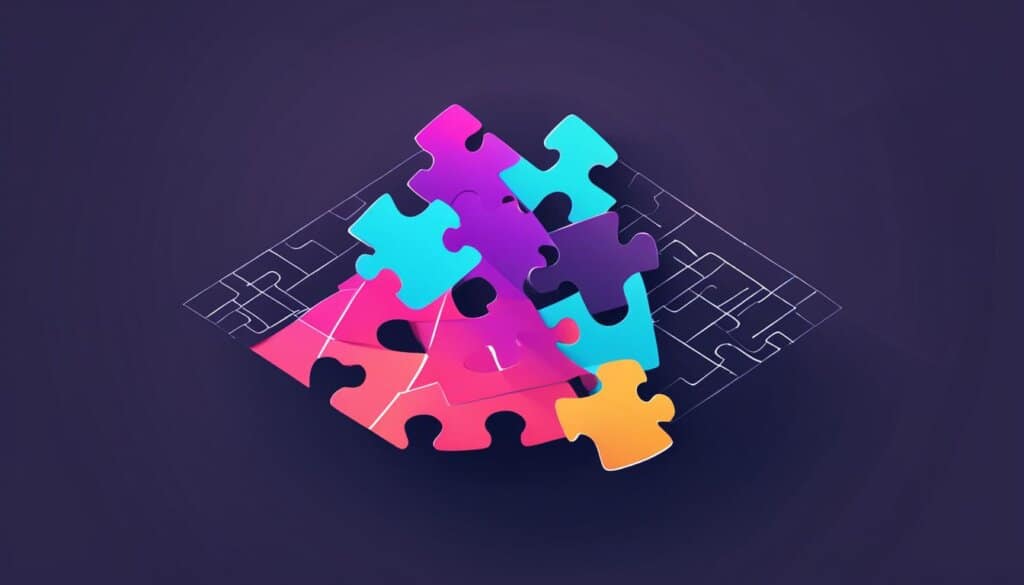Table of Contents
GraphQL is a powerful query language and runtime that has revolutionized modern development. Its primary uses involve streamlining APIs and enhancing web performance. Unlike traditional RESTful APIs, GraphQL allows clients to send queries to a server and receive only the data they need in a single response, making it more efficient. This flexibility and efficiency make GraphQL a popular choice for developers across various applications and development stacks.
Whether it’s front-end development, mobile development, or back-end development, GraphQL provides a flexible and efficient way to request and manipulate data from a server. By cutting down on unnecessary data transfers and reducing the number of API requests, GraphQL improves application performance and user experience. It enables developers to design APIs that precisely match the requirements of their applications and optimize data retrieval.
In the next sections, we will dive deeper into how GraphQL works, where it fits in the development stack, and how to implement it in backend development. By the end of this article, you’ll have a comprehensive understanding of GraphQL and its incredible uses in modern development.
How Does GraphQL Work?
In GraphQL, queries have a simple structure and are easy to understand. The client sends a query to the server, specifying the data they need. The server has a schema, which defines the types of data available and the relationships between them. Resolve functions specify how the data for each field in the schema is fetched.
“GraphQL queries allow clients to request specific data from the server, avoiding over-fetching or under-fetching of data, which can occur in traditional RESTful APIs.”
The server parses the query, validates it against the schema, and then executes it. Execution involves calling the resolve functions to fetch the requested data. The execution flow follows a cascading fashion, starting from the root of the query and going down the tree.
Query Example:
query {
user(id: "123") {
name
email
posts {
title
content
}
}
}
Schema Example:
| Type | Name | Description |
|---|---|---|
| User | id: ID | The unique identifier for a user |
| User | name: String | The name of the user |
| User | email: String | The email address of the user |
| User | posts: [Post] | The posts created by the user |
| Post | title: String | The title of the post |
| Post | content: String | The content of the post |
By following this structure, GraphQL enables efficient data fetching and reduces the complexity of managing multiple endpoints. It provides developers with a flexible and powerful tool for executing queries and retrieving data in a streamlined manner.
Where Does GraphQL Fit in the Development Stack?
When considering the development stack, it’s essential to understand the role of GraphQL and its impact on the different layers. In a traditional stack without GraphQL, there are three primary layers: the UI layer, the service layer, and the data layer.
The UI layer comprises the clients that interact with the service layer through APIs. These clients, such as web or mobile applications, send requests to the service layer to fetch or manipulate data. The UI layer focuses on presenting the data to the users and handling user interactions.
On the other hand, the service layer acts as an intermediary between the UI and the data layer. It exposes APIs that the UI layer can query or modify data through. The service layer is responsible for handling the business logic, validating requests, and executing operations on the data layer.
The data layer consists of the data stores or databases that hold the application’s data. These can include relational databases, NoSQL databases, or any other data storage solution. The service layer interacts with the data layer to fetch or persist data based on the UI layer’s requests.
“By introducing GraphQL into the development stack, several improvements can be realized in terms of communication and data fetching.”
However, as applications become more complex, managing multiple endpoints and the increasing complexity of communication between these layers can become challenging. This is where GraphQL fits in.
Introducing the Graph Layer
GraphQL introduces a graph layer between the service layer and the UI layer, bringing significant benefits to the development stack. The graph layer acts as a unified API for clients to interact with, enabling efficient data retrieval and manipulation.
With GraphQL, clients can query for exactly the data they need, reducing unnecessary data transfer and improving performance. The graph layer takes care of aggregating the requested data from multiple sources, including multiple data stores or third-party services, and presenting it in a unified manner to the clients.
“The graph layer in GraphQL simplifies communication between the UI and service layers, providing a single endpoint to fetch and manipulate data.”
By adopting GraphQL, the development stack evolves to include the graph layer:
| Development Stack | Layer |
|---|---|
| Without GraphQL | UI Layer |
| Service Layer | |
| Data Layer | |
| With GraphQL | UI Layer |
| Graph Layer (GraphQL) | |
| Service Layer | |
| Data Layer |
As shown in the table above, the introduction of the graph layer with GraphQL provides a more efficient and flexible way to handle communication and data retrieval between the UI and service layers.

- The ability to fetch only the required data, reducing unnecessary data transfer and enhancing performance.
- A simplified and unified API for clients to interact with, eliminating the complexity of managing multiple endpoints.
- A flexible way to aggregate data from different sources and present it to clients in a consistent manner.
By incorporating the graph layer with GraphQL, developers can streamline the communication and data retrieval process, leading to more efficient, scalable, and maintainable applications.
Implementing GraphQL in Backend Development
Implementing GraphQL in backend development involves several steps. Firstly, a schema needs to be defined that describes the types of data the API will expose and the relationships between them. The schema acts as a blueprint for the GraphQL API, specifying the available data and how it can be queried or mutated.
Once the schema is defined, resolvers need to be set up for each field in the schema. Resolvers are functions that fetch the data for a specific field from the underlying data sources or services. They are responsible for retrieving the requested data and returning it to the GraphQL server. By setting up resolvers, you can control how data is fetched and processed, enabling efficient data retrieval based on client queries.
Middleware can also be implemented in the backend development process. Middleware functions sit between the client’s request and the server’s response, allowing for additional functionality such as authentication, authorization, and caching. By including middleware, you can add layers of security, control access to certain data, and cache frequently accessed data to improve performance.
Choosing the right GraphQL server library or framework is crucial for successful implementation. There are several options available, such as Apollo Server, GraphQL Yoga, and Prisma, each with its own features and capabilities. The server library or framework handles the execution of queries and mutations, provides tools for schema management, and often integrates with existing backend technologies.
Testing and documentation are essential aspects of implementing GraphQL in backend development. Unit tests should be written for the resolvers to ensure their correctness and reliability. Additionally, the GraphQL schema should be thoroughly documented to provide clear instructions and examples of how to use the API for client developers. By investing time in testing and documentation, you can ensure the stability, maintainability, and usability of your GraphQL API.
FAQ
What is GraphQL used for?
GraphQL is used in modern development to streamline APIs and enhance web performance.
How does GraphQL work?
GraphQL queries have a simple structure and allow clients to send requests to a server and receive only the data they need in a single response. The server has a schema that defines the types of data available and the relationships between them. Resolve functions specify how the data for each field is fetched. The server parses and validates the query against the schema, then executes it by calling the resolve functions in a cascading fashion.
Where does GraphQL fit in the development stack?
In a typical development stack without GraphQL, there are three layers: the UI layer, the service layer, and the data layer. GraphQL introduces a new layer called the graph layer, which replaces the need for multiple endpoints and simplifies communication between the layers. The UI layer interacts with the service layer through GraphQL APIs, and the service layer accesses the data layer.
What are the steps to implement GraphQL in backend development?
To implement GraphQL in backend development, the following steps are involved: define a schema that describes the types of data and their relationships, set up resolvers for each field to fetch the data, implement middleware for tasks such as authentication and authorization, choose a GraphQL server library or framework for server implementation, write unit tests for the resolvers, and document the GraphQL schema for client understanding. Finally, the GraphQL client is implemented on the frontend to send queries and mutations to the GraphQL server.













